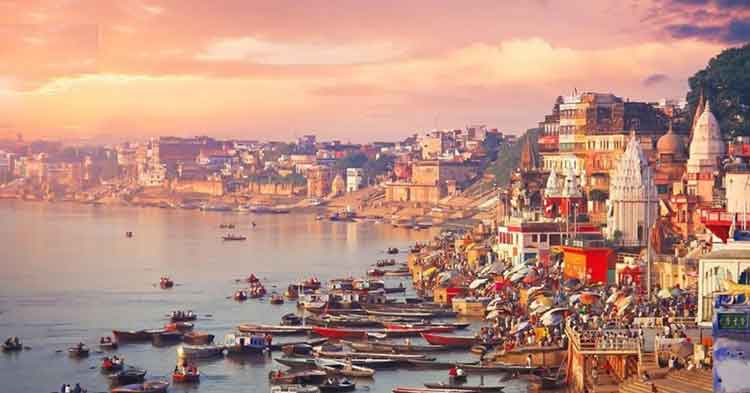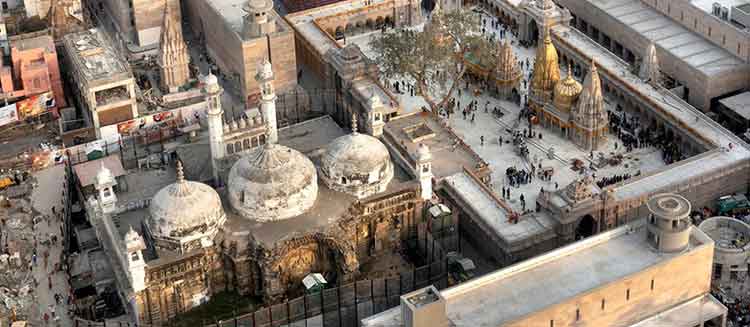Table of Contents
Kashi Vishwanath Temple – An Introduction
The Kashi Vishwanath Temple, one of the most revered and ancient temples in India, holds a significant place in the hearts of millions of Hindus. Located in the holy city of Varanasi (also known as Kashi), this temple is dedicated to Lord Shiva, the Supreme God in Hinduism. In this comprehensive exploration of the Kashi Vishwanath Temple, we will delve into its historical, religious, cultural, and architectural aspects, providing a thorough understanding of its importance and the spiritual aura it exudes.
The Kashi Vishwanath Temple, often referred to as the Golden Temple, is a manifestation of divine spirituality and a symbol of eternal sanctity. The Kashi Vishwanath Temple is located in Varanasi, which is regarded as one of the oldest cities still in existence. It is a symbol of the region’s rich spiritual and cultural legacy.
Historical Background of Kashi Vishwanath Temple
Ancient Origins
The roots of the Kashi Vishwanath Temple can be traced back to ancient times, with references found in Hindu scriptures and texts. The sacred city of Varanasi itself has been a center of spirituality and learning for thousands of years, making it a natural home for a temple dedicated to Lord Shiva.
Rebuilding and Renovations
Throughout history, the temple has faced destruction and reconstructions due to various invasions and rulers. The present structure is believed to have been built by Maharani Ahilyabai Holkar of Indore in the 18th century. The temple has undergone multiple renovations and expansions over the centuries, each contributing to its grandeur and significance.
Religious Significance of Kashi Vishwanath Temple
Lord Shiva and Jyotirlinga
The Kashi Vishwanath Temple is home to one of the twelve Jyotirlingas, sacred representations of Lord Shiva. The Jyotirlinga in Kashi is believed to be self-manifested and holds immense spiritual importance for devotees. Pilgrims from all corners of the world visit the temple to seek the blessings of Lord Shiva and to attain moksha (liberation from the cycle of birth and death).
Spiritual Magnetism
The spiritual energy of the Kashi Vishwanath Temple is unparalleled. The belief is that a single visit to the temple and a glimpse of the Jyotirlinga can wash away sins and bestow divine grace upon the devotee. The temple is not merely a physical structure but a sacred space where spirituality comes alive.

Architecture and Design of Kashi Vishwanath Temple
Temple Complex
The Kashi Vishwanath Temple complex is a sprawling area that includes the main temple dedicated to Lord Shiva. The complex also houses several smaller shrines dedicated to various deities, each contributing to the holistic spiritual experience.
Golden Spire
The temple is renowned for its towering golden spire, which is a striking feature that can be seen from a distance. The intricate detailing and craftsmanship on the spire make it a masterpiece of Hindu temple architecture.
Courtyards and Halls
Within the temple complex, there are several courtyards and halls that serve different purposes. The Vibhuti Bhavan is where sacred ash (vibhuti) is distributed to devotees. The Bhagwan Nandi temple, dedicated to Lord Shiva’s mount, Nandi, is another significant structure within the complex.
Rituals and Festivals of Kashi Vishwanath Temple
Daily Pujas
The temple follows a strict routine of daily pujas (worship rituals). Devotees can witness various rituals performed by the temple priests, adding to the spiritual ambiance of the place. A heavenly environment is created by the ringing of bells, the rhythmic chanting, and the scent of incense.
Maha Shivaratri
Maha Shivaratri, the great night of Lord Shiva, is celebrated with unparalleled fervor at the Kashi Vishwanath Temple. Devotees throng the temple precincts to offer special prayers and witness the grand festivities that include processions and cultural events.
Cultural Significance of Kashi Vishwanath Temple
Varanasi: The Spiritual Hub
The Kashi Vishwanath Temple is an integral part of the cultural tapestry of Varanasi. The city, situated on the banks of the sacred river Ganges, is a melting pot of tradition, art, music, and spirituality. The temple contributes significantly to the cultural vibrancy of Varanasi.
Ghats and Pilgrim Traditions
The temple is closely connected to the numerous ghats along the Ganges where pilgrims perform various rituals. Taking a dip in the holy river, known as Ganga Snan, is considered purifying, and devotees often combine this with a visit to the Kashi Vishwanath Temple.
Challenges and Conservation Efforts
Historical Challenges
The temple has faced numerous challenges throughout its existence, including destruction by invaders and disputes over ownership and control. These challenges reflect the complex history of the region and the resilience of the devotees in preserving their sacred heritage.
Contemporary Conservation
In recent times, efforts have been made to preserve and restore the Kashi Vishwanath Temple. Conservation projects aim to maintain the architectural integrity of the temple while improving facilities for the millions of pilgrims who visit each year.
Pilgrimage and Tourism of Kashi Vishwanath Temple
The Spiritual Journey
For millions of Hindus, a pilgrimage to the Kashi Vishwanath Temple is a once-in-a-lifetime journey. Pilgrims undertake arduous travels, often covering vast distances, to experience the divine presence of Lord Shiva at this sacred site.
Tourism Impact
The temple is not only a spiritual center but also a major tourist attraction. The influx of tourists contributes to the local economy and provides an opportunity for cultural exchange. However, it also poses challenges in terms of managing crowds and preserving the sanctity of the site.

Kashi Vishwanath Temple: Historical and Contemporary Disputes
The Kashi Vishwanath Temple, located in Varanasi, Uttar Pradesh, is one of the holiest Hindu temples dedicated to Lord Shiva. Its historical significance and religious importance have made it a focal point of several disputes over the years. This essay explores the historical and contemporary disputes associated with the Kashi Vishwanath Temple.
Ancient Background:
The history of the Kashi Vishwanath Temple dates back to ancient times, with the original temple believed to have been built by Maharaja Harishchandra in the 2nd millennium BCE. The temple has undergone several renovations and reconstructions under different rulers, including the Marathas and the Mughals.
One of the most significant historical disputes surrounding the temple occurred during the Mughal era when Emperor Aurangzeb ordered the demolition of the original temple in 1669 and the construction of the Gyanvapi Mosque in its place. This event remains a point of contention and historical debate.
Also Read: Mysterious Temples of India | Most Valuable Temples in the World
Post-Independence Disputes:
After India gained independence in 1947, discussions surrounding the restoration and management of religious sites became a critical issue. The Kashi Vishwanath Temple was no exception. The post-independence period saw debates regarding the control and administration of the temple and its surrounding area.
Controversies emerged over the Vishwanath Corridor project, a redevelopment initiative aimed at expanding and beautifying the temple premises. While supporters lauded the efforts to enhance the pilgrimage experience, critics raised concerns about the displacement of local residents and the potential impact on the historical fabric of the area.
Legal Battles:
Legal battles over the ownership and control of the Kashi Vishwanath Temple have been a recurrent theme. Various court cases have been filed by different parties, including religious and community groups, contesting the management and administration of the temple.
The courts have had to navigate complex issues related to religious freedom, property rights, and cultural heritage preservation. The legal disputes have often reflected broader societal tensions and debates over secularism and the role of the state in religious affairs.
Also Watch: Scientific Reason Behind Ringing Bell and Blowing Conch in Temple
Contemporary Issues:
In recent years, the Kashi Vishwanath Temple has been at the center of discussions surrounding cultural identity, historical preservation, and religious practices. The government’s initiatives to develop the temple premises and the surrounding area have been met with mixed reactions from different sections of society.
There are ongoing debates about the impact of modernization on the temple’s spiritual atmosphere and the need to balance development with the preservation of the site’s historical and cultural integrity. Additionally, questions about inclusivity and accessibility for devotees from different backgrounds have been raised.
Conclusion
In conclusion, the Kashi Vishwanath Temple stands as a beacon of spiritual enlightenment and cultural richness. Its ancient origins, religious significance, architectural marvels, and the cultural vibrancy of Varanasi collectively make it a jewel in the crown of India’s heritage. The temple is not merely a structure made of stone and gold; it is a living testament to the enduring faith and devotion of millions who continue to seek solace and divine blessings within its sacred precincts. As the spiritual heart of Varanasi, the Kashi Vishwanath Temple continues to draw seekers and believers, providing a timeless connection to the divine.
